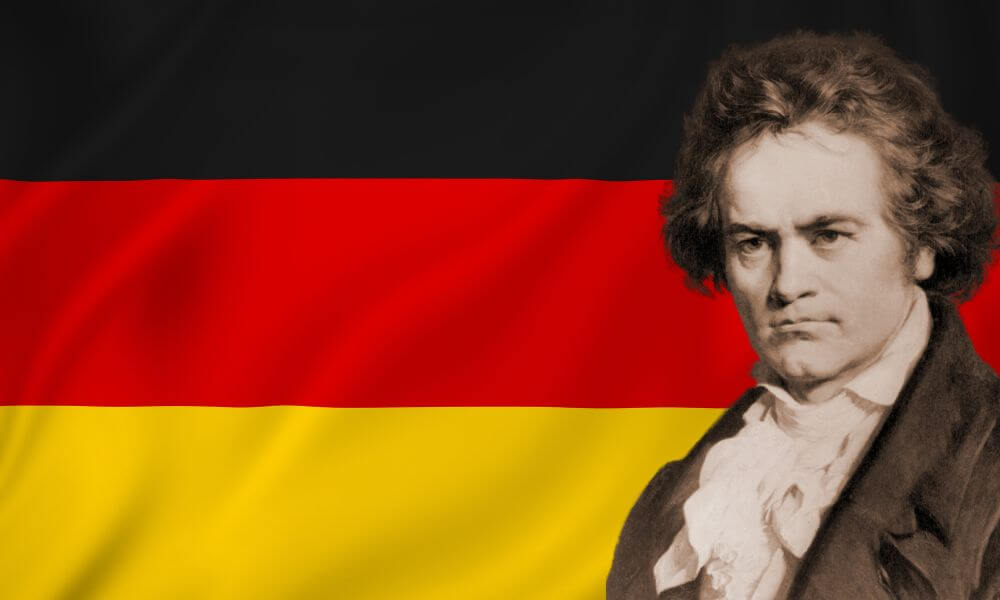Ludwig van Beethoven, one of history’s greatest composers, was born in Bonn, Germany in 1770 and died in Vienna, Austria in 1826. Naturally, Beethoven’s mother tongue was German. Since German is also the language spoken in Austria, Beethoven would have spoken it throughout his life.
The German language finds its roots in the West Germanic group of the Indo-European languages family tree.
Other languages that stem from West Germanic include English, Dutch and Frisian (a language spoken today by half a million people in mainly coastal regions of Germany and the Netherlands).
Roughly 76 million people currently speak German as their native language with another 80-85 million speaking it as their second language, making it the 12th most spoken language in the world.
German is considered a pluricentric language and as of 2022, 6 countries have it as their national language.
This list includes Germany, Austria, Switzerland, Belgium, Liechtenstein, and Luxembourg.
The first recorded interaction with German speakers comes from the 1st century BCE after their first contact with Romans.
There are 3 early forms of German: Old High German, Middle High German, and Early New High German.

What Was Old High German?
Until about the 6th century AD there was one single Germanic language with minor differences appearing from dialects.
From this time onwards, the first true “German” language was developed.
High German, or Hochdeutsch, was the first official written language of Germany and differed from its contemporary, Low German, in its sound system, particularly when it came to consonants.
The first written record of Old High German came from the Latin/Old High German glossary text, Abrogans, written in c. 765-775 AD.
It wasn’t until the ninth century that more works started to appear.
These included:
Hildebrandslied: The earliest poetic text in German and sole surviving example of Old High German heroic poetry. It dates to c. 800 AD and chronicles the tragic tale of a battle between a father and a son who does not recognise him.
Merseburg Incantations: The only surviving example of Pagan German belief, the Merseburg Incantations details two medieval spells, charms or incantations. It was discovered in 1941.
Ludwigslied: The short poem celebrates the victory of Louis III of France over Viking Raiders. It is written in the Christian ethos and presents the Vikings as a punishment from God.
What Was Middle High German?
The period for Middle High German is inconclusive however an agreed timeline is that it lasted from 1050 AD to 1350 AD.
During this time, Germanic tribes expanded their territory, bringing their language with them and spreading its influence to new regions.
The language featured the unvoicing of final b, d and g letters and the reduction of unstressed vowels to a and was used in the creation of a number of important works.
Nibelungenlied: An epic poem written in the 13th century chronicling the exploits of legendary dragon-slaying hero, Siegfried.
Iwein: A verse romance adapted from Arthurian legend and written around 1203 AD.
What Was Early New High German?
Early New High German rose to prominence following the Black Death which occurred from 1346-1353.
It lasted for roughly 300 years until 1650.
Throughout this time Early New High German would displace Latin as the primary language of courtly proceedings and literature in German states.
This was aided by the invention of the printing press c. 1440 and the publication of Luther’s Bible in 1534, both of which had a major impact in standardizing the German language.
What is the German Alphabet?
Like English, the German alphabet contains 26 core letters, A through Z.
There are four bonus letters in the language, three umlauts (Ä, Ö, Ü) and a ligature (ß).
In Switzerland and Liechtenstein this ß is not present and written instead as ss. In this way,
German can be considered to have 26, 29 or 30 letters depending on location and what letters are included.
All these letters use the same article, das. Like English, A, E, I, O and U are the vowels.
What Does Van Mean in German?
Confusion sometimes comes from Ludwig van Beethoven’s name as to what language he might have spoken and where he came from.
The use of the Dutch van in his name as opposed to the German von comes from his ancestors.
The words van and von mean ‘of’ or ‘from’, hence Beethoven’s translated name is ‘Ludwig of Beethoven’ or ‘Ludwig from Beethoven’.
What Are Indo-European Languages?
Indo-European languages are a family of languages native to Europe, India and the Iranian plateau.
The first instance of an Indo-European language dates back to 4,500 BC and is known as Proto-Indo-European (PIE).
Today 46% of the world’s population speak an Indo-European language as their native language, far greater than any other language family.
Some of the most spoken Indo-European languages today are English, Hindi, Spanish, Bengali, Portuguese and Russian, all of which boast over 100 million native speakers.
What is a Pluricentric Language
A pluricentric or polycentric language is a language with several interacting standard forms.
An example of this would be the differences in English across the world.
In England people speak British English whereas in America people speak American English.
German is considered to be an asymmetric pluricentric language.
This means that one codified standard of the language is dominant above the others, here being the one used in Germany.
Other codes include the lesser known Austrian Standard German and Swiss Standard German.
Ludwig van Beethoven spoke German though the van in his name signifies his Dutch heritage.
German is a West Germanic language that stemmed from the Indo-European languages family.
There are three early forms of German: Old High German, Middle High German and Early New High German.
It is known as a pluricentric language though the version of the language originating from Germany is the dominant codified standard.
More in Languages
- What Language Did Abraham Speak? (Explained!)
- What Language Did Adam And Eve Speak? (Answered!)
- What Language Did Albert Einstein Speak? (Wunderbar!)
- What Language Did Alexander The Great Speak? (Answered!)
- What Language Did Anne Frank Speak? (It May Surprise You!)
- What Language Did Beethoven Speak? (Revealed!)
- What Language Did Boudicca Speak? (Explained!)
- What Language Did Bruce Lee Speak? (Answered!)
- What Language Did Catherine The Great Speak? (Answered!)
- What Language Did Cavemen Speak? (Explained!)
- What Language Did Christopher Columbus Speak? (Answered!)
- What Language Did Cleopatra Speak? (Explained!)
- What Language Did George Washington Speak? (Revealed!)
- What Language Did Jesus Speak? (Answered!)
- What Language Did Julius Caesar Speak? (Find Out!)
- What Language Did Moses Speak? (Answered!)
- What Language Did Mozart Speak? (Answered!)
- What Language Did Noah Speak? (Explained!)
- What Language Did The Anglo Saxons Speak? (Answered!)
- What Language Did The Aztecs Speak? (Answered!)
- What Language Did The Buddha Speak? (Explained!)
- What Language Did The Vikings Speak? (Answered!)
- What Languages Are Spoken In Afghanistan? (Find Out!)
- What Languages Are Spoken In Africa? (Revealed!)
- What Languages Are Spoken In Albania? (Answered!)
- What Languages Are Spoken In America? (Answered!)
- What Languages Are Spoken In Antwerp? (Find Out)
- What Languages Are Spoken In Argentina? (Revealed!)
- What Languages Are Spoken In Australia? (Find Out!)
- What Languages Are Spoken In Austria? (Answered!)
- What Languages Are Spoken In Bangladesh? (Revealed!)
- What Languages Are Spoken In Barcelona? (Answered!)
- What Languages Are Spoken In Belgium? (Revealed!)
- What Languages Are Spoken In Bolivia? (Answered!)
- What Languages Are Spoken In Bosnia? (Answered!)
- What Languages Are Spoken In Brazil? (Find Out!)
- What Languages Are Spoken In Budapest? (Revealed!)
- What Languages Are Spoken In China? (Answered!)
- What Languages Are Spoken In Colombia? (Revealed!)
- What Languages Are Spoken In Croatia? (Answered!)
- What Languages Are Spoken In Cuba? (Revealed!)
- What Languages Are Spoken In Cyprus? (Revealed!)
- What Languages Are Spoken In Denmark? (Find Out!)
- What Languages Are Spoken In Djibouti? (Answered!)
- What Languages Are Spoken In Ecuador? (Find Out!)
- What Languages Are Spoken In Egypt? (Answered!)
- What Languages Are Spoken In El Salvador? (Answered!)
- What Languages Are Spoken In England? (Find Out!)
- What Languages Are Spoken In Eritrea? (Helpful Content!)
- What Languages Are Spoken In Estonia? (Revealed!)
- What Languages Are Spoken In Ethiopia? (Answered!)
- What Languages Are Spoken In Fiji? (Revealed!)
- What Languages Are Spoken In Finland? (Find Out!)
- What Languages Are Spoken In Germany? (Answered!)
- What Languages Are Spoken In Japan? (Answered!)
- What Languages Are Spoken In Morocco? (Answered!)
- What Languages Are Spoken In South Africa? (Answered!)

